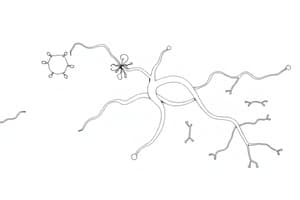Podcast
Questions and Answers
What is the effect of vasoconstriction on the lumen of a blood vessel?
What is the effect of vasoconstriction on the lumen of a blood vessel?
- It decreases the lumen size. (correct)
- It causes the vessel to expand.
- It has no effect on the lumen size.
- It increases the lumen size.
In the context of blood flow, what happens when the lumen of a blood vessel is reduced?
In the context of blood flow, what happens when the lumen of a blood vessel is reduced?
- Vascular resistance decreases.
- Blood flow remains unchanged.
- Blood flow increases significantly.
- Vascular resistance increases. (correct)
What is the role of smooth muscle in blood vessels during vasoconstriction?
What is the role of smooth muscle in blood vessels during vasoconstriction?
- It becomes inactive during vasoconstriction.
- It relaxes to allow more blood flow.
- It dilates the blood vessel.
- It contracts to reduce the diameter of the vessel. (correct)
Which side of the blood vessel is referred to as the proximal side?
Which side of the blood vessel is referred to as the proximal side?
What happens in the area of a blood vessel undergoing vasoconstriction compared to an area with no change?
What happens in the area of a blood vessel undergoing vasoconstriction compared to an area with no change?
What occurs to blood pressure proximal to the site of increased resistance caused by vasoconstriction?
What occurs to blood pressure proximal to the site of increased resistance caused by vasoconstriction?
What is the effect of vasoconstriction on blood vessel lumen?
What is the effect of vasoconstriction on blood vessel lumen?
In which scenario does total peripheral resistance increase?
In which scenario does total peripheral resistance increase?
What is the primary consequence of increased resistance in blood vessels?
What is the primary consequence of increased resistance in blood vessels?
What happens to blood flow when there is a bottleneck in the vessel due to vasoconstriction?
What happens to blood flow when there is a bottleneck in the vessel due to vasoconstriction?
What percentage of blood flow typically goes to the kidneys and GI tract at rest?
What percentage of blood flow typically goes to the kidneys and GI tract at rest?
What describes the condition when multiple arteries simultaneously constrict?
What describes the condition when multiple arteries simultaneously constrict?
How does vasoconstriction affect smooth muscle in blood vessels?
How does vasoconstriction affect smooth muscle in blood vessels?
What happens to blood pressure when it encounters resistance in the vasculature?
What happens to blood pressure when it encounters resistance in the vasculature?
How does total peripheral resistance influence systemic arterial blood pressure?
How does total peripheral resistance influence systemic arterial blood pressure?
What role do atherosclerotic plaques play in vascular resistance?
What role do atherosclerotic plaques play in vascular resistance?
What is the consequence of smooth muscle hypertrophy in blood vessels?
What is the consequence of smooth muscle hypertrophy in blood vessels?
How does hematocrit affect total peripheral resistance?
How does hematocrit affect total peripheral resistance?
What is a result of vasoconstriction in blood vessels supplying the kidneys?
What is a result of vasoconstriction in blood vessels supplying the kidneys?
What effect does backward blood flow due to increased resistance have on the aorta?
What effect does backward blood flow due to increased resistance have on the aorta?
Flashcards are hidden until you start studying
Study Notes
Vasoconstriction and Vascular Resistance
- Vasoconstriction, the narrowing of blood vessels, increases vascular resistance, making it harder for blood to flow through.
- The narrowing caused by vasoconstriction creates a bottleneck, increasing pressure proximal to the constriction.
- The pressure increase occurs due to blood accumulating and backing up before the narrowed area.
Total Peripheral Resistance (TPR)
- TPR reflects the overall resistance to blood flow throughout the circulatory system.
- Vasoconstriction in multiple organs, like kidneys, gastrointestinal tract, and skin, simultaneously increases TPR.
- Increased TPR leads to a buildup of blood pressure in the aorta, ultimately increasing systemic arterial blood pressure.
Factors Influencing TPR
- Atherosclerotic plaques: Damage to endothelial cells and plaque formation within blood vessels increase resistance to blood flow, contributing to higher TPR.
- Inward remodeling: Smooth muscle hypertrophy in arteries can permanently reduce the lumen size, increasing resistance even in a relaxed state.
- Elevated hematocrit: An increased percentage of red blood cells in the blood makes the blood thicker (more viscous), causing greater friction and resistance to flow, leading to higher TPR.
### Sympathetic Nervous System's Role in TPR
- The sympathetic nervous system plays a significant role in regulating TPR.
- It causes vasoconstriction of arteries and arterioles through adrenergic receptors.
- This vasoconstriction ultimately increases TPR and blood pressure.
Sympathetic Nervous System & Total Peripheral Resistance
- The sympathetic nervous system causes vasoconstriction of arteries and arterioles.
- Vasoconstriction increases total peripheral resistance (TPR).
- Increased TPR leads to increased systemic arterial blood pressure.
Factors Affecting TPR
- Atherosclerosis (plaques in blood vessels) increases TPR.
- Artery/arterial remodeling (inward remodeling) increases TPR.
- Increased hematocrit (proportion of red blood cells in blood) increases TPR.
Studying That Suits You
Use AI to generate personalized quizzes and flashcards to suit your learning preferences.



